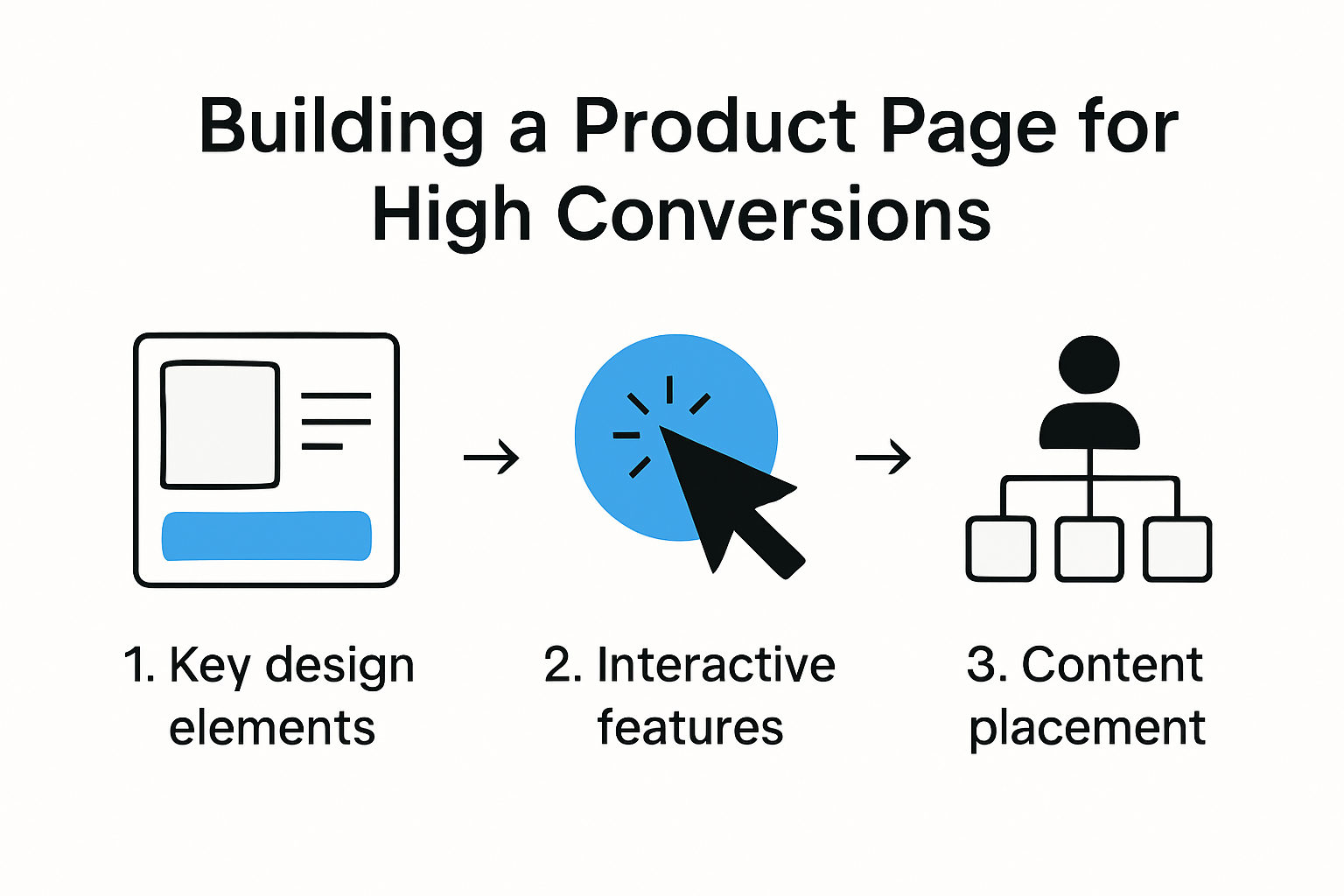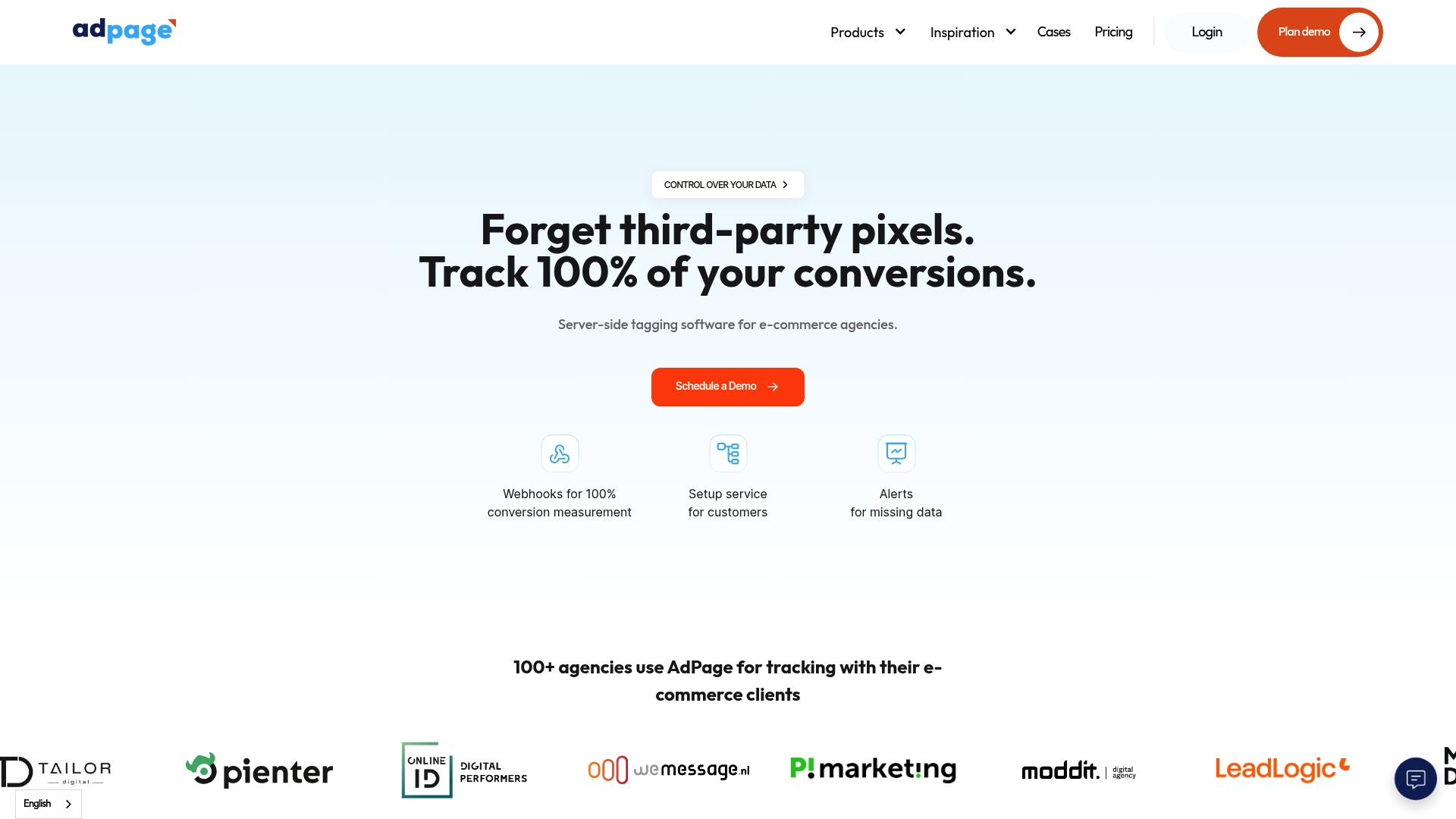Online shoppers make most buying decisions in less than 90 seconds after landing on a product page. That sounds fast and simple, right? Yet a single misplaced button or unclear photo can drop conversion rates by more than 20 percent. The secret is that tiny design tweaks and clever content hold the real power and in 2025 the biggest wins will go to brands that master the small things others overlook.
Table of Contents
- Design Elements That Boost Engagement
- Crafting Highly Persuasive Product Content
- Advanced Strategies For Conversion Rate Optimisation
- Using Analytics To Refine Product Page Performance
Quick Summary
| Takeaway | Explanation |
|---|---|
| Establish a clear visual hierarchy | Prioritize key information using layout techniques to aid user decision-making. |
| Incorporate interactive design elements | Features like zoom, 360-degree views, and instant pricing engage users actively. |
| Craft persuasive product narratives | Create emotionally resonant stories that highlight benefits, not just features. |
| Build trust through transparency | Offer clear pricing, stock information, and realistic policies to reduce hesitation. |
| Utilise advanced analytics for insights | Analyse user behaviour to identify conversion barriers and optimise product pages. |
Design Elements That Boost Engagement
Product page design represents a critical intersection between visual communication and user experience that directly impacts conversion rates. Understanding how design elements influence user behaviour becomes paramount for e-commerce success in 2025.
Visual Hierarchy and Information Architecture
A strategic approach to design begins with establishing a clear visual hierarchy that guides users through product information effortlessly. Research from design psychology studies reveals seven fundamental design elements critical for user engagement: navigation, graphical representation, organization, content utility, purpose, simplicity, and readability.
Successful product pages prioritize critical information through intentional layout techniques. This means positioning key details such as pricing, key features, and purchase options where users naturally focus their attention. Designers should create visual pathways that reduce cognitive load and enable quick decision making.
To provide a clear overview, the following table summarises the seven fundamental design elements critical for user engagement on product pages as highlighted by research:
| Design Element | Description |
|---|---|
| Navigation | Guides users through the page easily |
| Graphical Representation | Uses visuals to communicate information |
| Organization | Structures content logically |
| Content Utility | Ensures information is useful and relevant |
| Purpose | Aligns design with user and business goals |
| Simplicity | Avoids unnecessary complexity |
| Readability | Maintains legibility for all content |
Interactive and Responsive Design Elements
Retail website design research demonstrates that user flow significantly influences conversion potential. Interactive design elements like hover states, dynamic product imagery, and intuitive navigation can transform passive browsing into active engagement.
Implementing responsive design goes beyond mobile compatibility. It involves creating adaptive interfaces that respond to user interactions in real time. Consider incorporating features like:
- Zoom capabilities for product images
- 360-degree product views
- Configurable product options
- Instant price calculation tools
These interactive elements provide users with a more immersive and informative shopping experience.
Balancing Visual Intensity and User Experience
While visual appeal matters, overwhelming design can deter potential customers. Advanced design methodology studies suggest a nuanced approach to visual intensity. The goal is creating a design that is aesthetically pleasing without compromising functionality.
Key strategies include using whitespace effectively, maintaining consistent colour schemes, and ensuring typography remains legible across devices. Typography should support readability while reflecting brand personality. Select fonts that are clean, professional, and easy to read across different screen sizes.
colour psychology plays a crucial role in user perception. Choose colour palettes that align with your brand identity and evoke the desired emotional response. Subtle colour variations can highlight critical information, create visual hierarchy, and guide user attention towards conversion points.
Learn more about optimising ad performance to complement your product page design strategy and maximize user engagement.

Crafting Highly Persuasive Product Content
Product content represents the critical bridge between customer curiosity and conversion. Creating compelling narratives that transform passive browsers into active purchasers requires strategic communication techniques and deep understanding of consumer psychology.
Language and Narrative Strategies
Advanced research on e-commerce marketing content reveals sophisticated approaches to generating persuasive product descriptions. Large language models demonstrate the potential to increase click-through rates by 12.5% and conversion rates by 8.3% through intelligent content generation techniques.
Effective product content goes beyond mere description. It needs to tell a story that resonates with the target audience’s aspirations and pain points. This means crafting language that is simultaneously informative, emotionally engaging, and solution-oriented. Use active voice, vivid descriptors, and focus on benefits rather than just features.
Consider transforming technical specifications into compelling narratives. Instead of listing dimensions and materials, explain how these characteristics translate into tangible user experiences. For instance, rather than stating “waterproof material”, describe “protection that keeps you dry during unexpected downpours”.
Building Trust Through Transparent Information
Research on e-commerce optimization indicates that transparency dramatically influences purchasing decisions. Providing real-time stock levels creates a sense of urgency and builds customer confidence.
Key transparency elements include:
- Clear pricing with no hidden charges
- Accurate stock information
- Detailed shipping and return policies
- Comprehensive product specifications
Customers appreciate businesses that provide complete, honest information. This approach reduces purchase hesitation and builds long-term trust.
The table below organises the transparency elements that help build trust on product pages and the benefits they deliver to customers:
| Transparency Element | Benefit to Customer |
|---|---|
| Clear pricing | Eliminates surprises, aids purchase decisions |
| Accurate stock information | Sets clear expectations, reduces frustration |
| Detailed shipping & return policies | Builds confidence, clarifies commitments |
| Comprehensive product specifications | Helps informed choices, shows integrity |
Leveraging Social Proof and User Experiences
Expert analysis on product page optimization emphasizes the profound impact of social proof. Customer reviews, testimonials, and user-generated content serve as powerful conversion tools by validating product quality through authentic experiences.
Strategically integrate social proof elements:
- Display verified customer reviews
- Showcase user-submitted photos and videos
- Highlight professional endorsements
- Include trust badges and certifications
These elements transform product pages from mere transactional spaces into trusted recommendation platforms. By amplifying genuine user voices, you create a more compelling and credible purchasing environment.
Explore advanced content marketing techniques to further refine your approach to persuasive product storytelling.
Advanced Strategies for Conversion Rate Optimisation
Conversion rate optimisation represents a sophisticated approach to transforming potential customer interactions into measurable business outcomes. As digital landscapes become increasingly competitive, businesses must adopt advanced techniques that go beyond traditional conversion strategies.
Adaptive Content Recommendation Systems
Research on multi-armed bandit algorithms reveals groundbreaking approaches to dynamically optimise content recommendations. By implementing intelligent algorithmic strategies like Thompson Sampling, businesses can achieve remarkable improvements in user engagement. The study demonstrates a potential 6.13% increase in click-through rates and a 16.1% increase in conversion rates compared to standard recommendation approaches.
Adaptive recommendation systems analyse user behaviour in real time, creating personalised experiences that feel intuitive and responsive. These systems continuously learn from user interactions, adjusting content and product suggestions to match individual preferences and browsing patterns.
Automated Product Description Generation
Advanced research in e-commerce copywriting highlights the transformative potential of automated content generation. By utilizing transformer-pointer networks and pre-trained sequence-to-sequence models, businesses can generate high-quality product descriptions at scale. A case study on JD.com’s platform revealed a 4.22% increase in click-through rates and a 3.61% increase in conversion rates through automated description techniques.
Key advantages of automated product description generation include:
- Consistent language quality
- Rapid content production
- Scalable description creation
- Data-driven content optimization
The technology enables businesses to create compelling, contextually relevant product narratives that resonate with specific customer segments.
Deep Learning for Product Recommendations
Innovative deep learning approaches are revolutionising alternative product recommendation strategies. By integrating textual product information with sophisticated customer behaviour analysis, businesses can enhance recommendation accuracy and potentially increase conversion rates by up to 12%.
Deep learning models excel at understanding complex user interaction patterns, enabling more nuanced and precise product suggestions. These systems consider multiple data points including browsing history, purchase patterns, and contextual relevance to generate recommendations that feel genuinely personalised.
Implementing such advanced recommendation strategies requires a robust technological infrastructure and a commitment to continuous learning and adaptation. Businesses must invest in sophisticated data analysis tools and machine learning capabilities to remain competitive.
Discover expert conversion optimization techniques to further enhance your digital marketing approach.
Using Analytics to Refine Product Page Performance
Analytics represent the cornerstone of intelligent product page optimization, providing granular insights into user behaviour, conversion dynamics, and performance bottlenecks. By transforming raw data into actionable intelligence, businesses can systematically enhance their e-commerce platforms.
Traffic Source and Conversion Analysis
Research examining e-commerce traffic interactions reveals the critical importance of understanding user engagement pathways. Comprehensive analytics enable businesses to dissect conversion factors, identifying precise moments where potential customers either progress or abandon their purchasing journey.
Key metrics to monitor include:
- Bounce rates for individual product pages
- Time spent on page
- Click-through rates on product recommendations
- Conversion funnel drop-off points
By mapping these metrics, businesses can create targeted interventions that address specific user experience challenges. For instance, high bounce rates might indicate misaligned product descriptions or unclear value propositions.
Intelligent Recommendation Optimization
Advanced neural network research demonstrates the transformative potential of data-driven recommendation systems. Deep learning algorithms can dynamically optimize item recommendation modules, significantly enhancing click-through and conversion rates compared to static configurations.
Effective recommendation optimization involves:
- Personalizing product suggestions
- Analysing user browsing patterns
- Implementing machine learning models
- Continuous performance tracking
These intelligent systems learn from each user interaction, progressively refining recommendation accuracy and relevance.
Predictive Performance Modeling
Predictive analytics transforms historical data into future insights, enabling proactive product page optimization. By leveraging machine learning algorithms, businesses can anticipate user behaviour, identify potential conversion barriers, and implement preemptive improvements.
Strategic approaches include:
- Segmenting user behaviour patterns
- Developing predictive conversion models
- Identifying emerging user experience trends
- Creating dynamic page configurations
This forward-looking approach allows businesses to stay ahead of evolving user expectations, continuously adapting product pages for maximum engagement.
Explore comprehensive analytics strategies to unlock deeper insights into your e-commerce performance.

Frequently Asked Questions
How can I improve the visual hierarchy on my product pages?
To enhance visual hierarchy, position key information like pricing and features prominently using layout techniques that guide user attention naturally. Prioritise readability and focus on reducing cognitive load to aid decision-making.
What interactive elements should I include on product pages?
Incorporate features such as zoom capabilities for images, 360-degree views, and dynamic price calculation tools to engage users actively and provide a more immersive shopping experience.
How does transparent information build trust on product pages?
Providing clear pricing, stock levels, and detailed shipping and return policies instils confidence in customers, reducing hesitation and encouraging them to complete purchases.
What role does social proof play in conversion rates?
Social proof, such as verified customer reviews and user-generated content, validates product quality and authenticity, significantly enhancing credibility and increasing conversion rates.
Take Your Product Page Optimisation Further With Data-Driven Precision
Are your product pages failing to meet their true conversion potential even after investing in better design, engaging content, and interactive experiences? Many businesses overlook the crucial impact of accurate data collection and tracking. In 2025, where every design adjustment and content change directly affects your bottom line, missing conversion events or facing inaccurate analytics can undermine all your hard work. The article highlights that the right content and experience can make a difference, but without precise insight into real customer behaviour, your optimisation efforts remain incomplete.

Do not let your growth be limited by outdated tracking systems or incomplete data. Discover how AdPage empowers you to monitor 100 percent of conversions through robust server-side tagging, powerful consent management, and airtight GDPR compliance. Shopify, WooCommerce, or Magento, our seamless integration solutions ensure every visitor action is captured for smarter, faster optimisation. Take control of your conversion data and accelerate your e-commerce performance today by visiting AdPage’s homepage.



.png)
